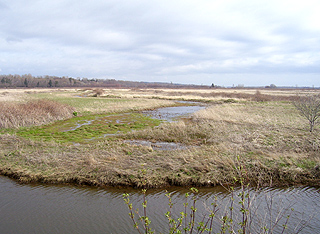
Surveys
DJC.COM
July 30, 2009
A watershed approach to mitigation and restoration
ESA Adolfson

Clancy
|
Recent developments at the federal, state and local levels are changing the way we approach environmental mitigation and the restoration of fragile ecosystems such as Puget Sound.
Agencies including the U.S. Army Corps of Engineers, U.S. Environmental Protection Agency, Washington Department of Ecology, Puget Sound Partnership, some tribal governments and many local governments are beginning to embrace, in earnest, a shift toward “ecosystem-based” mitigation and restoration strategies. This shift follows a nationwide trend whereby the greater watershed and its functions (i.e., the ecosystem) are considered when planning mitigation and restoration projects.
Mitigation decisions in Washington state historically have been made on a site-by-site or project-by-project basis. A developer seeking a permit to fill or alter a wetland has been required to mitigate the impact by providing a replacement wetland on-site, or as close to the impact site as possible. Too often this default practice of so-called “permittee-responsible, on-site mitigation” failed to fully offset the impacts allowed by the permit.
The paradigm is beginning to shift. In April of 2008, the Army Corps of Engineers and Environmental Protection Agency issued new mitigation guidance encouraging applicants for Clean Water Act permits to use an ecosystem approach — as opposed to a site-oriented approach — when planning mitigation actions.

Photo courtesy of ESA Adolfson
The Lummi Nation is working with the Corps of Engineers and the Environmental Protection Agency to establish a wetland and habitat mitigation bank on the Lummi Indian Reservation. |
By clarifying standards regarding the use of mitigation banks and in-lieu fee programs, the federal rule paved the way for broader use of off-site mitigation tools, especially when off-site mitigation provided greater benefit to the watershed or ecosystem. The agencies’ willingness to amend their long-held preference for on-site mitigation was largely motivated by a National Research Council study which found that “mitigation efforts that do not involve full consideration of landscape factors and ecosystem processes are unlikely to contribute to the goals of the Clean Water Act.”
Ecosystem-based mitigation decisions are informed by a broad understanding of the dynamic physical, biological and chemical processes that shape the landscape. This is the approach that the state Department of Ecology embraced in its December 2008 “Mitigation that Works” report. This report, which had broad support from business interests, tribes, conservation groups and resource agencies, noted that when impact and mitigation decisions are based on an understanding of ecosystem processes, we are better able to direct mitigation investments to places that will be sustainable and successful over time.
Ecology asserts that this approach requires a wider range of mitigation tools than we have traditionally employed, and ultimately produces better ecological results. Developers and permit applicants benefit by having more mitigation options to choose from and better alternatives to the standard permittee-responsible approaches that have yielded mixed success.
King County may be one of the first local jurisdictions to capitalize on this new policy guidance. In June, the county issued a proposal to establish the King County Mitigation Reserves In-Lieu Fee Program.
The program would allow a permit applicant to satisfy mitigation obligations by purchasing mitigation credits from an approved site owned by King County or protected by a conservation easement. The county selects the eligible mitigation sites based on ecological screening criteria that take into account critical watershed or ecosystem needs.
If the program is approved, it would provide an alternative to the traditional on-site mitigation approach and would be consistent with the new federal guidance.
Similar policy changes are occurring in the restoration arena. As with mitigation, many of our past attempts to restore environmental damages amounted to piecemeal efforts to recreate habitats or correct site-specific symptoms of ecological decline. Today, nearly all of the major entities involved in restoring Puget Sound emphasize the need for a new strategy.
A 2007 document by scientists from the National Oceanic & Atmospheric Administration Northwest Fisheries Science Center noted that an ecosystem-based approach is the best means of improving our ability to implement cost-effective restoration actions.
Our state’s primary blueprint for restoring Puget Sound, the Puget Sound Partnership’s 2020 Action Agenda, recommends that we characterize watershed conditions throughout Puget Sound as an initial step.
The partnership is acting on this recommendation by commissioning a large-scale watershed characterization effort in conjunction with the Department of Ecology. The results of the characterization will be made available to local governments and restoration entities throughout the region, so that we can all have a better understanding of how the Puget Sound ecosystem works and what needs to be done to protect and restore its myriad habitats and species.
This information could have important implications for local governments who are updating shoreline master programs, implementing critical area ordinances, and making comprehensive planning decisions. Improving our understanding of ecosystem dynamics and processes provides a path forward for local governments seeking to improve mitigation and restoration outcomes and for developers seeking a more predictable permit process. Best of all, the application of these principles is anticipated to reduce mitigation and restoration costs, and result in greater success overall.
Margaret Clancy is the resource policy program manager for ESA Adolfson, an environmental solutions firm serving the Northwest for more than 20 years. Clancy specializes in multidisciplinary projects that blend science, planning, policy development and public outreach.
Other Stories:
- How people influence long-term sustainable success
- For a greener future, look to the past
- Going green with government tax incentives
- Puget Sound’s invisible enemy: polluted stormwater
- Are you sure you’re ready to go green?
- Is vapor intrusion the next regulatory juggernaut?
- Fish find refuge on the lower Puyallup River
- Improving water quality in Holmes Harbor
- Why buildings can never be regenerative
Copyright ©2009 Seattle Daily Journal and DJC.COM.
Comments? Questions? Contact us.